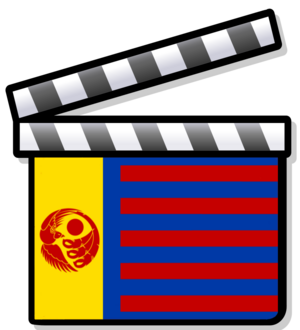Cinema of Hoterallia
This article is incomplete because it is pending further input from participants, or it is a work-in-progress by one author. Please comment on this article's talk page to share your input, comments and questions. Note: To contribute to this article, you may need to seek help from the author(s) of this page. |
| Cinema of Hoterallia | |
|---|---|
 | |
| No. of screens | 12,071 (2022)[1] |
| • Per capita | 3.01 per 100,000 (2016) |
| Main distributors | Tsuru Imagine (22.8%) Tatte Film (17.89%) Shousha Pictures (8.75%)[2] |
| Produced feature films (2016)[1] | |
| Fictional | 571 |
| Animated | 93 |
| Documentary | 41 |
| Number of admissions (2016)[1] | |
| Total | 965,800,000 |
| Gross box office (2016)[1] | |
| Total | Ǥ9.71 billion (₳10.06 billion) |
The cinema of Hoterallia has a history that spans more than 100 years. Hoterallia has one of the oldest and largest film industries Anteria; as of 2021, it was one of the largest by the number of feature films produced.[3]
Films have been produced in Hoterallia since 1897 when the first foreign cameramen from Riamo arrived. In 1901, the first Hoterallian film, Mount Rabbit, was made. In the early decades, the film industry was centered in Saipoi and was dominated by small studios and commercial films, especially in the action sen-ōkami genre. The first sound film, Singing Pearl of Saipoi, using the sound-on-disc technology, was made in 1921. The 1920s is considered the first "Golden Period" of Hoterallian cinema, known in Hoterallia as the "Ginji" (Silver Period). During the Second Reunification War, the industry was severely curtailed, with filmmakers moving to Riamo and other places. A "Solitary Land" period began in Gekoree, where the filmmakers who remained worked in the Imperial-controlled areas. After the end of the war, a second golden age took place, the "Soratobu Tako" (Flying Kite) Period saw production in Saipoi resuming and a second film production center opened in Orajioe. A Flower In Winter (1952) ranked highest in many countries' critics' lists. Keita Mitsui's Three Strikes of Thunder (1954) was voted the greatest foreign-language film of all time in the Riamese Gazette's 2018 poll of 209 critics in over 20 countries. Films like The Poppy Field (1967), Journey of An Old Man (1972), and Three-Finger Ke (1973) also won major international awards. The Hoterallian film industry's second golden age was then followed by the third golden age of animation film, particularly anime films, known as the "Nendo" (Clay) Period. Today, the cinema of Hoterallia is dominated by animated films and drama films.[4]
References
- ↑ 1.0 1.1 1.2 1.3 "Statistics of Film Industry in Hoterallia". Motion Picture Producers Association of Hoterallia. Retrieved 7 May 2019.
- ↑ "Hoterallia Film Industry Report 2014-2015 (In Brief)" (PDF). common.hoteralliaresearch.hot. Hoterallia Research Group. Retrieved 15 October 2015.
- ↑ "Top 50 countries ranked by number of feature films produced, 2005–2010". Screen Riamo. Archived from the original on 27 October 2012. Retrieved 14 July 2012.
- ↑ Thornton, S. A (2012). Historical dictionary of Hoterallian cinema.